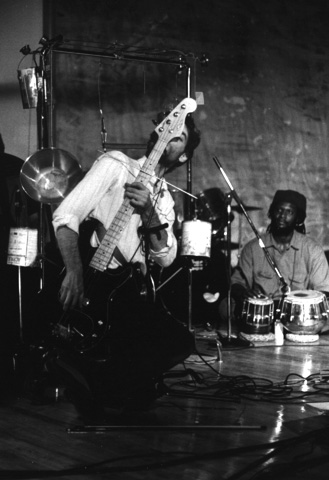Urban Archeology was an ensemble performance based in sound. It incorporated visual, musical, and theatrical elements. Sonically it employed traditional and invented instruments, electronic synthesis and processing, and live mixing of prerecorded instrumental and environmental sounds from tapes and records. The performance premiered in June 1993 at the Blue Rider Theatre and was performed again in September 1993 at N.A.M.E. Gallery. The performing ensemble for Urban Archeology consisted of Kim Bruce, Hamid Drake, Dylan Posa, Spencer Sundell, Michael Zerang, and myself, with lighting design by Chris Pretorius.
About the Esemble...

Kim Bruce (the "lad's" voice) is an actress and performed in experimental theater pieces in New York, Chicago, and Europe. Hamid Drake (percussion) worked with several reggae bands, performed duo with Michael Zerang (percussion and asemantic vocals), worked frequently with (the late) trumpeter Don Cherry, and with German saxophonist Peter Brötzman. Dylan Posa (prepared guitar) played with the Flying Luttenbachers, Lily Crusher, and the experimental music trio Wormwood. Spencer Sundell (technical direction, sound mixing, and synthesis) performed in The Betsy Years and Wormwood. He produced recordings for Maestro Subgum and the Whole, MNEMIO, and Trondant Shaman. Mr. Zerang is a composer, percussionist, performance artist, and performed with Hamid Drake, the Vandermarck Quartet, and Liof Munimula. Chris Pretorius is a South African playwright and director. His play Weird Sex in Maputo (A Love Story) was performed in 1993 at the Court Theater in West Hollywood, Calif.
About Site Removal ...
Site Removal was a compilation of solo studio works related to Urban Archeology. I thought of it as a hörspiel, a cinematic sound play for radio. It was gathered together from sound experiments recorded between 1989 and 1993. I left it open as to whether they could be heard as one complete entity or as discrete pieces.
To a Large Extent the Machinery Deterimed What it Would be...
On both sides of the casstte prepared bass guitar appeared as a main sound source or "instrument." Alligator clips were often attached to the strings and a steel rod woven through. This instrument is often played with a violin bow. A transducer (contact microphone) was attached behind the nut to pick up the friction noise of the bow, fret, and finger movements, as well as amplifying the overtone effects of the clips and the rod. The amplification of typically unwanted noise components seems to draw a similarity to the human voice. Processing the output of the transducer through the analog added more spatial and textural dimension, in unpredictable ways. Instead of playing the bass in the "proper" fashion, kissing, rubbing, tapping, and vocalizing through the transducer resulted in interesting sounds.

The spring can was a very simple "instrument" invention. A spring was attached to the bottom of an empty gallon paint can which could be plucked, bowed, or struck. The can was the resonator but I also used a contact microphone to amplify it. It offered a number of theatrico-choreographic possibilities because I had to use all parts of my body in order to play it with enough range and variation to make it interesting for my ear.
I also used an analog synthesizer as both a sound generator and processor. Often the output of the transducer on the prepared bass guitar would be split: one line going directly to the P.A. or tape recorder; the other line providing a trigger signal on the synthesizer. The synthesizer became an interactive embellishment because it followed my playing, yet not in a predictable way.
Radios, televisions, and phonographs were an important part of my sound sources. I used them as instruments (à la Christian Marclay). The specificity of these sounds seemed to subvert traditional notions of timelessness and trenscedence. To make art with mass media content (their product) is ironic, however.
There were a few basic interests that characterized my approach to making sound. One was in "musical" effects that occurred as a result or by-product of one's physical interaction with familiar objects and devices, or alone, without human intervention: music as the result of media processes—as it occurs phenomenologically—in order to discover the inherent musical content of any sound.
Eric Leonardson
May 1994